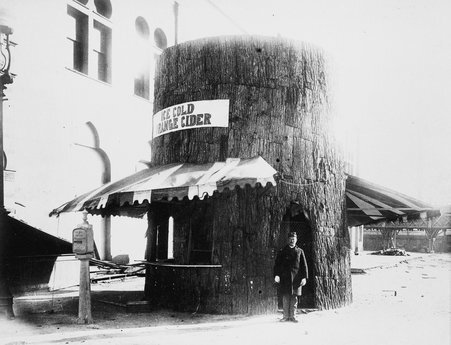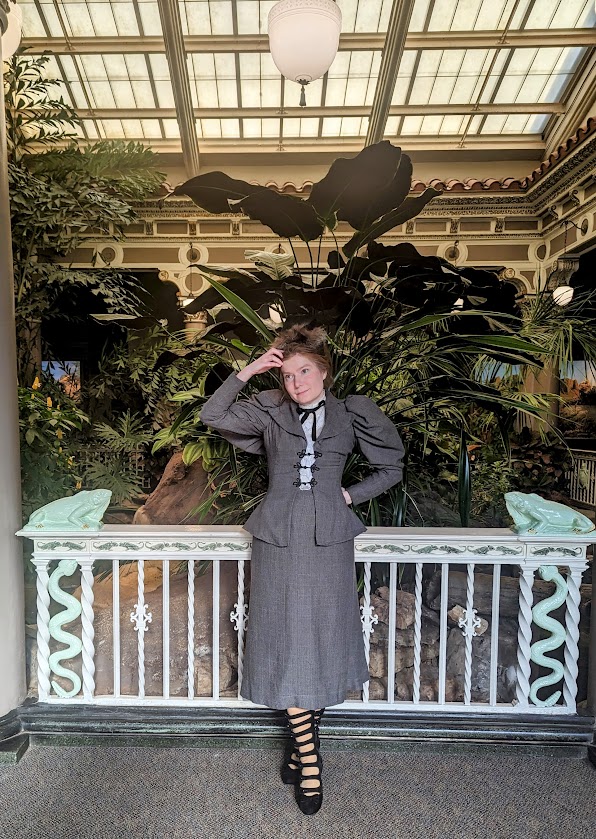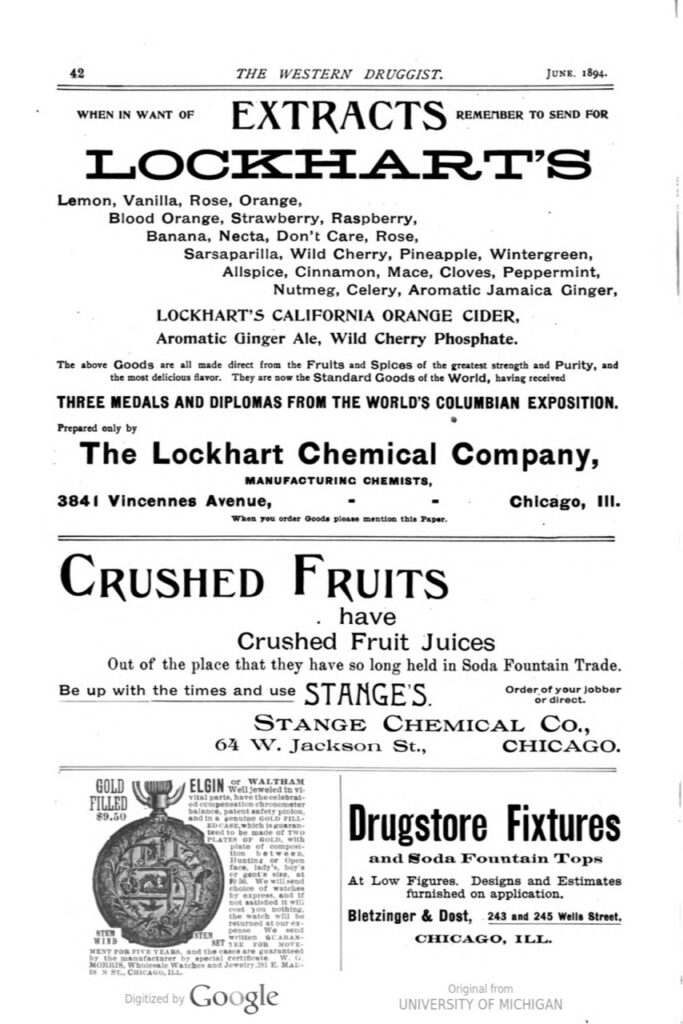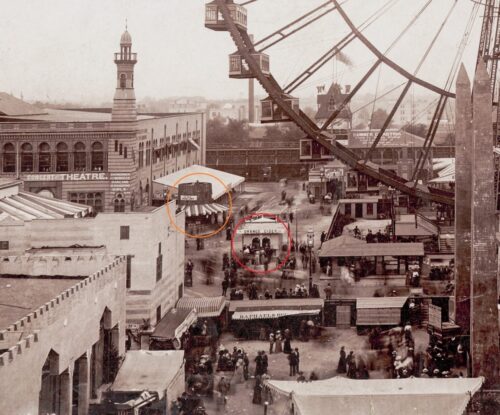
By Judy Carmack Bross

One of several 1893’s World’s Fair orange cider locations. Photo from the collection of the Chicago History Museum.
Orange Cider: Refreshing libation or bogus beverage?
Guests at the 1893 World’s Fair—and the newspapers that covered it–couldn’t make up their minds. So, in honor of National Citrus Month in January, the Chicago History Museum’s Research and Insights Analyst Marissa Croft shared history and recipes recently on a Museum blog which fascinated readers. She teamed with YouTuber Kaz Rowe to brew and taste recipes for the mysterious orange cider, the drink that swept the 1893 World’s Fair. Fittingly, the video is entitled: “Ranking the Weirdest Things at the 1893 World’s Fair.”

YouTuber Kaz Rowe and the Chicago History Museum’s Marissa Croft toast with orange cider, the “Drink of the Gods” from the 1893 World’s Fair.
The original orange cider was served in the Florida pavilion and several select locations at the fair for 5 cents a glass, probably very popular on a hot summer day to wash down the Vienna beef and Hershey’s chocolate that were so popular also at the Fair, matching the juicy fruit gum for refreshment.
One of the most noted vendors of this cider was Huelsenkamp, a Floridian beverage maker and distributer. According to a September 9, 1893 advertisement in the Chicago Daily Tribune, Huelsenkamp’s Orange Cider was sold at the Florida, Washington, and Illinois State Buildings, at the Midway by the Ice Railway, at the Big Tree at the side of the Vienna Café, and in the Streets of Cairo (p.3).

Orange Cider sold on the Midway.
“Just like today, food fads had great appeal, and artificial fruit flavoring, which was first introduced at the Great Exhibition of 1851, was being experimentally applied to all sorts of foods and beverages at the time” Croft said. “Historically, orange cider referred to a fermented brew made with actual oranges. However, this particular ‘orange cider’ of the 1893 Fair was occasionally referred to as a ‘bogus cider’ or fictitious wine’ in the press because it did not contain alcohol, and later, as some would allege that it didn’t even contain oranges!”

Marissa Croft in a costume of the 1890’s
Croft, who is working on her PhD at Northwestern in Rhetoric and Public Culture, is an expert on clothing from the 1890’s as well. Her dissertation is on clothing rhetoric of the French Revolution, but she also studies the women’s clothing reform movement of the late 19th century. The movement gained a lot of public attention during the Fair. “There were sessions hosted by the National Council of Women at the Arts Palace during the Fair to discuss abandoning the corset, shortening shirts and other changes to make clothing more practical.” Like so many, Croft dreams of what it would have been like to be a visitor to the 1893 Fair. “What would l like to do most? Buy an orange cider and take a ride on the Ferris wheel. I know the ride was a long one so it would be nice to take a beverage along.”
The Inter Ocean called Huelsenkamp’s cider at the Florida pavilion, “a temperance drink with the flavor of good old wine, rich and mellow” (June 25, 1893, p. 7). One Mr. Bowen Patterson said the orange cider in the Florida building must be “the drink of the gods” and the Dixon Evening Telegraph noted that the orange cider served in the Florida State Building “far excels in quality that found anywhere else on the grounds.”
However, as fall approached, other beverage vendors wanted in on the orange cider fad, but their imitations paled in comparison. According to a Chicago Daily Tribune article:
“There is a general complaint concerning the quality of the stuff now sold in the Exposition grounds as ‘orange cider.’ It was delicious when first introduced and became very popular, but prosperity seems to have spoiled it. Until the manufacturers return to first principles and make if of orange juice instead of vinegar, molasses, and various slops the Worlds’ Fair visitor will do well to let it alone.” (September 13, 1893, p. 12).
The Bureau County Tribune of Princeton Illinois reported that “The pure orange cider sold at the Worlds fair which has become such a popular drink, says an exchange, has been shown by analysis to have no relation to the orange at all. It is made from chemicals, part of them being very injurious to the system. A barrel of the stuff is worth 85 cents and nets the vendor by the glass $45.” (September 8, 1893, p. 8).
The debate of whether or not this orange cider was harmful to the drinker’s health persisted, and in a later October 9, 1893 Tribune article, reporters claimed the “orange cider” was only citric acid, molasses, lake Michigan water, and coloring matter and that it was “harmless and palatable.”
In an 1894 issue of the Florida Agriculturalist, the writer called on Florida orange grove owners to unite to insist that real oranges be used for making the drink, noting that grocery stores advertised they had bottled the most beloved drink of the World’s Fair and could sell it to customs for 18 cents per quart bottle or 60 cents for a gallon, also mentioning the flavor came from “vinegar, molasses, and a dab of soap for flavor” and not from oranges which were “going to waste in the groves.”

For those amateur chemists who sought to cash in on the orange cider’s success after the fair by selling a palatable drink, rather than a cheap brew of molasses and vinegar, Lockhart’s Chemical Company, located then on Vincennes Avenue in Chicago (who were proud to say they were the recipient of three medals and diplomas at the Fair) offered an array of extracts such as sarsaparilla, wild cherry, and orange. They sold these extracts to drugstores setting up a new pleasure of the late 19th century: the soda fountain. The orange cider sold after the Fair at these soda fountains was likely to be far superior to the soap-tinged products sold in bottles at grocery stores mentioned in The Florida Agriculturist.
Even though the original Orange Cider was a smash success, it was the cheap imitators that got more press in the end. The Chicago daily tribune called it “a soul-destroying concoction,” (Chicago Daily Tribune, October 22, 1893, p. 12). “This orange cider that was neither made from oranges, nor a true alcoholic cider soon became a punchline,” Croft wrote.

photo courtesy of Marissa Croft of the Chicago History Museum
Croft has adapted historic recipes for both orange ciders:
“If you’d like to try recreating this infamous historical drink, here are two recipes you can easily make at home. The first one approximates the original Floridian Huelsenkamp formula and is a very refreshing and tasty citrus beverage. It makes a great mixer for a cocktail or a more exciting version of lemonade for a summer picnic! The second recipe is for the cheap knockoff orange cider, and the resulting drink is unusual but not completely undrinkable, especially if you like unsweetened iced tea,” Croft writes.
Authentic Orange Cider Recipe
Makes 1 quart
Ingredients:
1 quart water
1 cup simple syrup (1 cup sugar and 1 cup water)
1/2 Tbsp citric acid
3/4 tsp orange extract
1/4 tsp orange sanding sugar, or more to achieve desired color
Stir well and serve over ice.
Knock-off “Orange Cider” Recipe
Ingredients—With a ½ teaspoon of ginger added, this beverage is called Switchel or Haymakers Punch. It was a drink popular with New England farmers.
Makes 1 quart
1 quart water
½ cup sugar
¼ cup molasses
¼ cup vinegar
Heat water in saucepan, add other ingredients and stir. Let cool or serve over ice.
For Further Reading, Croft recommended:
- The Inter Ocean Historic Newspaper – Available in person at the Abakanowicz Research Center or online through the Chicago Public Library with an active library card.
- The Chicago Daily Tribune Historic Newspaper – Available in-person at the Abakanowicz Research Center or online through the Chicago Public Library with an active library card. The Home Chemist; A Key to Honest Wealth by Prof. Duke H. Bashford, 1899. – “Lots of fun 1890’s recipes to taste and make at home!
Watch Croft and Rowe do a live taste test of the two ciders in the video “Ranking the Weirdest Things at the 1893 Chicago World’s Fair.”
To learn more about the World’s Fairs in Chicago, see the Chicago History Museum’s resource page: https://www.chicagohistory.org/worlds-fair-anniversaries/







